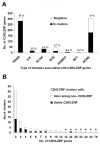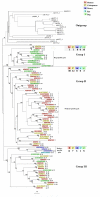Evolution of C2H2-zinc finger genes and subfamilies in mammals: species-specific duplication and loss of clusters, genes and effector domains
- PMID: 18559114
- PMCID: PMC2443715
- DOI: 10.1186/1471-2148-8-176
Evolution of C2H2-zinc finger genes and subfamilies in mammals: species-specific duplication and loss of clusters, genes and effector domains
Abstract
Background: C2H2 zinc finger genes (C2H2-ZNF) constitute the largest class of transcription factors in humans and one of the largest gene families in mammals. Often arranged in clusters in the genome, these genes are thought to have undergone a massive expansion in vertebrates, primarily by tandem duplication. However, this view is based on limited datasets restricted to a single chromosome or a specific subset of genes belonging to the large KRAB domain-containing C2H2-ZNF subfamily.
Results: Here, we present the first comprehensive study of the evolution of the C2H2-ZNF family in mammals. We assembled the complete repertoire of human C2H2-ZNF genes (718 in total), about 70% of which are organized into 81 clusters across all chromosomes. Based on an analysis of their N-terminal effector domains, we identified two new C2H2-ZNF subfamilies encoding genes with a SET or a HOMEO domain. We searched for the syntenic counterparts of the human clusters in other mammals for which complete gene data are available: chimpanzee, mouse, rat and dog. Cross-species comparisons show a large variation in the numbers of C2H2-ZNF genes within homologous mammalian clusters, suggesting differential patterns of evolution. Phylogenetic analysis of selected clusters reveals that the disparity in C2H2-ZNF gene repertoires across mammals not only originates from differential gene duplication but also from gene loss. Further, we discovered variations among orthologs in the number of zinc finger motifs and association of the effector domains, the latter often undergoing sequence degeneration. Combined with phylogenetic studies, physical maps and an analysis of the exon-intron organization of genes from the SCAN and KRAB domains-containing subfamilies, this result suggests that the SCAN subfamily emerged first, followed by the SCAN-KRAB and finally by the KRAB subfamily.
Conclusion: Our results are in agreement with the "birth and death hypothesis" for the evolution of C2H2-ZNF genes, but also show that this hypothesis alone cannot explain the considerable evolutionary variation within the subfamilies of these genes in mammals. We, therefore, propose a new model involving the interdependent evolution of C2H2-ZNF gene subfamilies.
Figures








References
Publication types
MeSH terms
Substances
LinkOut - more resources
Full Text Sources
Other Literature Sources

